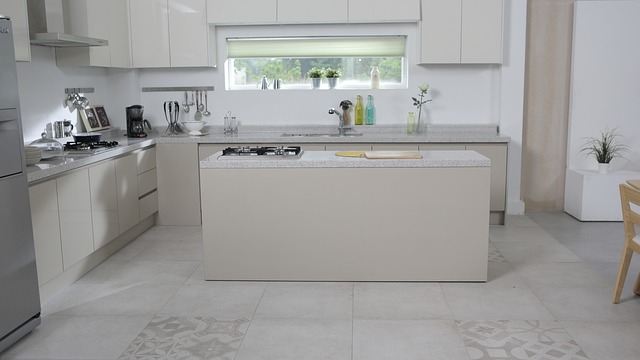Sealing gaps and integrating energy-efficient appliances are key to achieving a kitchen remodel for energy efficiency. An eco-friendly kitchen upgrade includes proper weatherproofing, high-quality caulk, and sustainable materials like LED low-energy lighting. Regular maintenance ensures the longevity of these green kitchen renovations, balancing aesthetics with energy conservation and contributing to a smaller environmental footprint.
Looking to transform your kitchen into an energy-efficient oasis? A successful kitchen remodel for energy efficiency involves understanding and sealing air leaks. This comprehensive guide explores the impact of air leaks on your home’s energy consumption and offers expert tips for a sustainable kitchen renovation. From eco-friendly kitchen upgrades to integrating energy-saving appliances and low-energy lighting, discover best practices for weatherproofing and maintaining a green kitchen that stands the test of time.
Understanding Air Leaks and Their Impact on Energy Efficiency in Kitchens
Air leaks in kitchens can significantly impact energy efficiency, often going unnoticed but costing you dearly on your utility bills. During a kitchen remodel for energy efficiency, it’s crucial to focus on sealing gaps around doors, windows, and appliances, as these are common entry points for unwanted air. Even tiny cracks can allow a considerable amount of warm or cool air to escape, leading to poor insulation and increased energy consumption. An eco-friendly kitchen upgrade isn’t just about installing sustainable kitchen renovation features; it’s also about minimizing drafts and preventing air leaks.
Consider the impact on your overall energy usage: a kitchen with proper weatherproofing and low-energy lighting for kitchens can enjoy substantial savings. Energy-saving kitchen appliances play a significant role in this, but they need to be part of an airtight, well-insulated space. This is where green kitchen remodeling comes into focus; it’s about creating an efficient, comfortable environment that reduces energy waste. By addressing air leaks during your sustainable kitchen renovation, you’ll not only lower your environmental footprint but also enjoy a more balanced indoor temperature throughout the year.
The Role of Proper Sealing in an Eco-Friendly Kitchen Renovation
Proper sealing plays a pivotal role in an eco-friendly kitchen renovation, ensuring that your space is not only aesthetically pleasing but also functional and environmentally conscious. When remodeling for energy efficiency, every detail matters. Sealing gaps around fixtures, windows, and doors prevents air leaks, which can account for significant energy loss in a kitchen. This simple step ensures that the energy-efficient kitchen design you’ve crafted remains just that—energy efficient.
Incorporating sustainable kitchen upgrades like low-energy lighting for kitchens further emphasizes your commitment to reducing environmental impact. By sealing and weatherproofing your kitchen properly, you create an airtight space that not only conserves energy but also contributes to a healthier indoor environment. This approach aligns with the broader trend of green kitchen remodeling, where every element is chosen with sustainability in mind.
Integrating Energy-Saving Appliances and Low-Energy Lighting for Optimal Performance
When planning a kitchen remodel with an eye towards energy efficiency, integrating energy-saving appliances and low-energy lighting is crucial. Upgrading to energy-efficient kitchen design doesn’t just reduce utility bills; it also contributes to a greener, more sustainable home. Appliances like induction cooktops, energy-star rated refrigerators, and efficient dishwashers significantly lower energy consumption without compromising performance.
Choosing eco-friendly kitchen upgrades, such as LED lighting fixtures, can further enhance these savings. LED lights consume up to 75% less energy than traditional incandescent bulbs and last much longer, reducing the need for frequent replacements. This simple yet effective strategy not only cuts down on electricity usage but also minimizes waste, making your kitchen renovation a truly green endeavor.
Best Practices for Weatherproofing During a Sustainable Kitchen Makeover
When undertaking a sustainable kitchen makeover, proper weatherproofing and sealing are crucial components for achieving energy efficiency. This involves ensuring all gaps and cracks around fixtures, windows, and doors are sealed tightly to prevent air leaks. Using high-quality, eco-friendly caulk and insulation materials is recommended, as these products not only provide an effective barrier against drafts but also contribute to a greener home.
Incorporating energy-saving kitchen appliances, such as low-energy lighting fixtures and efficient dishwashers, further enhances the sustainability of your remodel. Opting for LED lights with motion sensors or timers can significantly reduce electricity consumption. Additionally, choosing kitchen appliances with Energy Star ratings guarantees their efficiency in using less energy without compromising performance, aligning perfectly with a green kitchen renovation focus on environmental conservation.
Tips to Ensure Longevity and Maintainability After Your Green Kitchen Upgrades
After completing your green kitchen upgrade, ensuring longevity and maintainability is crucial. One key aspect is to maintain proper sealing and weatherproofing throughout the renovation. This includes using energy-efficient appliances that are designed for minimal energy consumption, such as low-energy lighting fixtures and smart thermostats. Regular maintenance checks can help identify any potential air leaks or damage caused by extreme weather conditions, allowing you to address issues promptly.
Additionally, focusing on sustainable materials and practices during the kitchen remodel for energy efficiency will contribute to a longer-lasting result. Opting for eco-friendly finishes, water-efficient fixtures, and proper insulation ensures that your kitchen remains not only aesthetically pleasing but also functional in terms of energy conservation. Regular cleaning and upkeep, including sealing grout lines and replacing worn-out seals, are simple yet effective ways to maintain the integrity of your green kitchen upgrades over time.
In conclusion, a successful kitchen remodel for energy efficiency involves integrating multiple strategies. By understanding air leaks and their impact, properly sealing and weatherproofing your space, selecting eco-friendly and energy-efficient appliances like low-energy lighting for kitchens, and prioritizing maintainability, you can achieve an optimal balance between sustainability and style in your green kitchen renovation. These best practices ensure not only a beautiful, functional kitchen but also significant long-term savings on energy costs.
